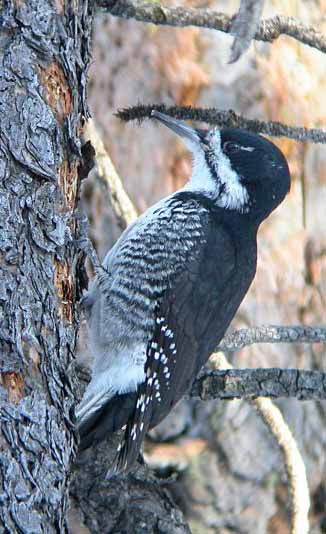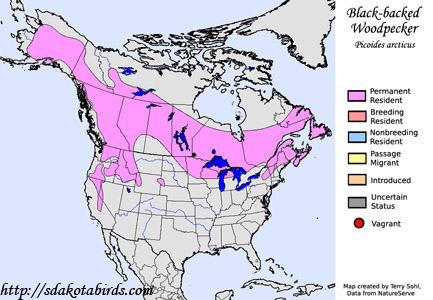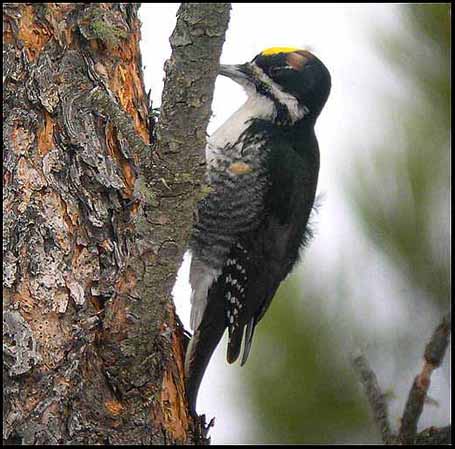| Length: 9.5 inches | Wingspan: 17 inches | Seasonality: All Seasons |
| ID Keys: Solid black back, barring on sides, white underparts, long sturdy bill, white mustache, yellow cap on head (male) | ||
 In South Dakota, the Black-backed Woodpecker is
generally found only in the higher elevation Black Hills, frequenting burned
forest areas and windfalls as well as healthy conifer forest. Feeding
primarily on wood-boring insects and insect larvae, they forage by stripping
large pieces of bark off of trees and feeding on the exposed insects. They
are closely related to the very similar Three-toed Woodpecker, and indeed used
to be called the "Black-backed Three-toed Woodpecker". A
female is depicted at the top, while a male (note the yellow cap) is depicted
below.
In South Dakota, the Black-backed Woodpecker is
generally found only in the higher elevation Black Hills, frequenting burned
forest areas and windfalls as well as healthy conifer forest. Feeding
primarily on wood-boring insects and insect larvae, they forage by stripping
large pieces of bark off of trees and feeding on the exposed insects. They
are closely related to the very similar Three-toed Woodpecker, and indeed used
to be called the "Black-backed Three-toed Woodpecker". A
female is depicted at the top, while a male (note the yellow cap) is depicted
below.
Habitat: They prefer areas of dead or dying conifers due to the larvae of wood-boring beetles that are often found in such areas. This includes burned, flooded, insect-damaged, or weather-damaged forests. They may also be found in healthy coniferous forests. In the U.S. and much of Canada, they are generally found in higher elevations. In the northern half of Canada, they are found in lowlands.
Diet: Primarily feeds on the larvae of wood-boring beetles. They will also eat other insects, spiders, fruits, and nuts.
Behavior: Moves methodically on trunks and major branches of dead standing trees and fallen logs, flaking off bark in search of insects underneath. They will also clamber along branches in live trees in search of insects, and move through foliage when foraging on fruits, nuts, and berries.
Nesting: June and July
Interactive eBird Map: Click to access an interactive map of Black-backed Woodpecker sightings
Song: Often quiet, but will occasionally make a single note, abrasive call, kyik.
Migration: Generally not migratory, but populations do shift as previously burned areas revegetate and new forest areas are burned or otherwise damaged.
Similar Species: Hairy Woodpecker, Three-toed Woodpecker
Status: Overall populations are relatively stable, but locally, populations rise and fall with availability of suitable habitat and associated forage insects.
Further Information: 1) USGS Patuxent Bird Identification InfoCenter, Black-backed Woodpecker
2) BirdWeb - Black-backed Woodpecker
3) Audubon Guide - Black-backed Woodpecker
Photo Information: Top Photo: March 6th, 2004 -- Near Sturgis -- Doug Backlund
Bottom Photo: March 14th, 2004 -- Vanocker Canyon -- Elizabeth Krueger and Scott Weins
| Click on the map below for a higher-resolution view |
 |
| South Dakota Status: Rare permanent resident in the Black Hills. |

